
William Turpin Bible (1815)
Enjoy a quick, in-depth look at a recently acquired object in the museum's collection: a Bible owned by William Turpin, a Charleston merchant and enslaver turned abolitionist. The Bible is currently on display in the new exhibition, The Story of Us, for a limited time. You can also learn more and explore this important historical object online.


















![SC2006.43.1- Cropped Image of Untitled [Canges-sur-Mer]](/sites/default/files/styles/wysiwyg/public/2023-07/Turpin%20Bible%20with%20Collections%20Staff.jpg?itok=AvfmogPX)